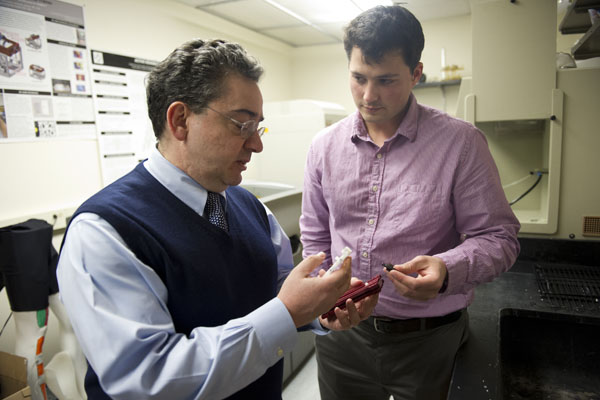The (second) life of an inventor

Constantinos Mavroidis hasn’t always been an inventor. “It was the spirit that already exists at Northeastern that got me started,” he said.
When the Distinguished Professor of Mechanical and Industrial Engineering came to Northeastern from Rutgers University in 2004, he had two patents issued to his name. Today he has more than three dozen that have been approved or are pending, an achievement that was recognized on Tuesday by his election to the National Academy of Inventors.
The high professional distinction is accorded to academic inventors who have demonstrated a prolific spirit of innovation by creating or facilitating outstanding inventions that have made a tangible impact on quality of life, economic development, and the welfare of society.
In the early days of his career, Mavroidis focused on theoretical research in robotics and mechanical systems, not on building devices. But when he came to Northeastern, the university’s entrepreneurial resources and culture convinced him that his work could have more of an impact.
“What fascinated me and became an objective when I came to Northeastern was to create new devices that could help people,” said Mavroidis. “Eventually what we develop in the lab will give us new products that could be useful to people in their everyday life or to improve their quality of life.”
Whenever his team starts a new project, he said, the researchers do a significant amount of background research to identify unfilled market needs. “Once you do this most of the time the new ideas come by themselves,” he said.
Since joining the College of Engineering faculty, Mavroidis has ushered more than 100 undergraduates through the invention and entrepreneurship process in addition to some 35 students pursuing master’s degrees and doctorates.
“A big reason for the huge number of inventions is the senior capstone design course,” he said. Every year, Mavroidis and his graduate students advise three undergraduate teams in bringing new ideas through to the development stage. All of them, he said, have lead to new inventions.
This semester alone, Mavroidis’ lab developed two new robotic devices for gait rehabilitation and a “smart bicycle” that prevents accidents through the integration of sensors.
Many of his inventions are in the area of medical robotics and mechatronics—or intelligent mechanical systems—but they also pervade a wide spectrum of applications. He is working with one student to develop a compact motor for use in the Mars rover, while another project is focused on developing new 3-D printers that allow users to embed electronic components into printed devices. “It’s a new kind of 3-D printing,” Mavroidis said, “but it’s also a new kind of robot.”
That project is one of two that have developed into a commercial enterprise, both of which are enjoying great success. 3-Spark, LLC, a spinoff of Mavroidis’ laboratory specializing in 3-D printing technologies for the education and consumer markets, was a finalist in the prestigious MassChallenge competition this year, while AndrosRobotics, which is working to commercialize the gait rehabilitation devices, is perusing government funding from the Small Business Technology Transfer program.
Mavroidis cites the Center for Research Innovation, Health Sciences Entrepreneurs, and IDEA, Northeastern’s student-run venture accelerator, as the driving forces behind his lab’s success. “CRI and the new team over there have cultivated a lot of innovation and an entrepreneurship spirit,” Mavroidis said. “They help us with the invention disclosure and patent application processes for everything we do or think in the lab and many of these things lead to new patents.” Once a new patent has been issued, the center has even helped commercialize the lab’s inventions.
Mavroidis—and 142 other inventors—will be inducted into the NAI during the 3rd Annual Conference of the National Academy of Inventors. The induction ceremony—led by the United States Patent and Trademark Office’s Deputy U.S. Commissioner for Patents Operations—will take place on March 7, 2014, in Alexandria, Va., at the headquarters of the U.S. Patent and Trademark Office.